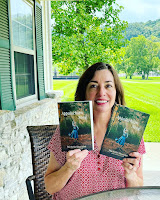Last month I blogged about the Appalachian Trail. I've been fascinated by all-things Appalachia since I began research for my novel Appalachian Song, and I enjoyed learning about the famous hiking trail. What I wasn't aware of, however, is that a trail running from New York to Alabama existed long before the Appalachian Trail was created.
Let me tell you about it.
The Great Indian Warpath was and is an ancient network of trails that were used by Native Americans hundreds of years before white European settlers came to this country. It is known by several names, including the Warriors' Path, the Great Indian War and Trading Path, and the Seneca Trail.
It is believed that many of the trails were broken first by animals, including herds of buffalo in the valleys of Virginia. The native people would follow the trails to hunt and eventually used them for moving from one region to another. Trading and communication between various tribes was aided by use of the trail. Sadly, as the name of the trail indicates, war also took place along the trail. Rivers played a major role in the location of the trail, as having a constant water source was vital. Many of the trails follow waterways through the hills and hollers of Appalachia.
 |
| The Seneca Trail |
far from Niagara Falls. (I wish I'd known about it when we visited Niagara Falls this past October! I'll definitely look for it the next time we're there.) This area was home to the Seneca Indian tribe, the largest of six Native American nations which comprised the Iroquois Confederacy or Six Nations, hence the name of the trail. The trail continued south through Pennsylvania, Maryland, West Virginia, Virginia, Tennessee, and Alabama.
Europeans eventually arrived in North America. Spanish explorer Hernando de Soto and his party are believed to be the first white people to travel the trail when they crossed the Blue Ridge Mountains in 1540. By the late 1600s, British colonists used portions of the trail as they traded with the Indians. The line of the Seneca Trail formed the boundary of "the frontier" at the time of the French and Indian War in 1756. When King George III issued a proclamation in 1763 forbidding further settlement beyond the mountains and demanding the return of settlers who had already crossed the Alleghenies, the Seneca Trail was once again used as a boundary.
 |
| Map of the "Great Indian Warpath" published in the Pennsylvania Magazine in October 1775 |
Today, parts of the Seneca Trail can still be accessed in various states. However, unlike the Appalachian Trail, it is not a continuous trail due to private land purchases and communities being built on it, but the history remains. People lived and died along those ancient footpaths. They are the souls I like to remember when I read about long ago days.
Your turn: Do you enjoy hiking in the woods? Would you seek out the Seneca Trail if you could?
Michelle Shocklee is the author of several historical novels, including Count the Nights by Stars, winner of the 2023 Christianity Today Book Award, and Under the Tulip Tree, a Christy Awards and Selah Awards finalist. Her work has been included in numerous Chicken Soup for the Soul books, magazines, and blogs. Married to her college sweetheart and the mother of two grown sons, she makes her home in Tennessee, not far from the historical sites she writes about. Visit her online at www.MichelleShocklee.com
APPALACHIAN SONG
Forever within the memories of my heart.
Always remember, you are perfectly loved.
Thirty years later, the day after his father’s funeral, Walker Wylie is stunned to learn he was adopted as an infant. The famous country singer enlists the help of adoption advocate Reese Chandler in the hopes of learning why he was abandoned by his birth parents. With the only clue he has in hand, Walker and Reese head deep into the Appalachian Mountains to track down Bertie Jenkins, the midwife who holds the secrets to Walker’s past.
https://www.tyndale.com/p/appalachian-song/9781496472441




Thank you for posting today, and Happy New Year to you and your family. I haven't done much walking in the woods, but I'd like to do more. With the tick invasion in the Northeast, I'd like to stick to groomed paths. That kind of spoils the ambiance of the forest but still, it's out in nature!
ReplyDeleteThe area where I grew up in southeastern Wisconsin was home to Potawatomi Native Americans, Geneva Lake was "discovered" by explorers from upstate New York and was named Geneva because the lake reminded the men of Lake Seneca back home. The Indians had blazed a trail around the entire lake which is about nine miles long and 22 miles in circumfrance. That trail still exists today and hikers can enjoy the view of many beautiful large homes as they hike the shore path. Other residents on the shoreline includ enclaves of summer cottages and summer camps. The shorepath is considered public like a sidewalk is in town and it must be protected and kept open to the hikers. I've been blessed to have been raised in such a beautiful and historic area where I've set many of my historical novels.
ReplyDelete